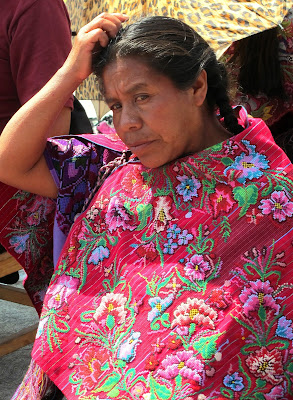San Juan Chamula is a small town located 10 km northwest of San Cristobal de Las Casas in the state of Chiapas, Mexico. This is where you will find the Tzotzil community. The Tzotzil Maya are one of the largest indigenous groups in Chiapas, around one third of the state’s indigenous population.
San Juan Chamula is the main hub of religion and commerce for the Tzotzil Maya.
I was extremely impressed on how brilliantly white-washed the Church of San Juan Bautista was.
It appears like any other church in the Highlands of Chiapas, but once inside, you feel like you have entered into another world. This is no ordinary Catholic church. There are no permanent clergy present, only guest priests are invited to perform the occasionally baptism. Once inside, you are hit with a pungent aroma, a mix of candles, pine needles, incense and flowers. Every Saturday the floor covered with pine needles is refreshed. There are a series of church bells in all sizes to the left as you enter. Statues of saints line the walls and most are kept in wood and glass boxes. The Tzotzil Maya practice different religious rituals, a blend of pre-Hispanic traditions with a little Catholicism thrown in. There are no pews. Not even an altar. Worshippers kneel on the floor. You will see the worshippers lighting their candles and chanting. These private ceremonies or rituals are are performed for various daily or family matters. In some of these rituals, eggs, live chickens, posh (a traditional cane sugar liquor) and Coco-Cola or Pepsie are used. Belching is a way to rid the body of bad spirits. Originally posh was used but the carbonated drinks had faster results and was soon adopted by the local Chamulan shamans.
A ticket is required to enter the church and can be purchased at the door for 40 pesos. Photography inside the church is strictly prohibited. I was lucky to find this photo on the internet.
San Juan Chamula has an elevation of 2,260 meters and it can get cold. Along side the road I would see neatly stacked piles of firewood. Not only was that an indication of the cold weather but also the way the Tzotzil people dressed.
The people of San Juan Chamula are easily identified by their attire. With the conquest came sheep which replaced the cotton and rabbit fur tunics. Most of the men wear white woolen tunics called jerkoil (from the Spanish jerga, or twill weave) which are belted at the waist.
The black sleeved robe is called a chuj, named after the chuj Maya of Guatemala, who used to make and sell these pieces of clothing in Chiapas. I have read that it is the village leaders who wear the black tunics.
The women wear embroidered huipils (blouses) made of cotton or satin, a shawl (mochebal) and woven wool skirts (tzequil) belted with a woven belt (chuquil). Since the 1990's, cardigan sweaters became popular when the evangelical missionaries came onto the scene and were handing these sweaters out to entice the locals to join their congregation.
The creation of the wool skirt changed in the early 2000's. The long wool fibers are woven and dyed. Then shrunk, felted and then combed out to create the two to three inch wool strands. The process is extremely time-consuming and expensive. These skirts keep them warm even when wet and it is wet in this area most of the year.
There is other significance in the tzequil, that they resemble the pelt of a Howler Monkey which can be seen (and heard) in the rain forest of Chiapas. The Howler Monkey and Spider Monkey are symbolic in their ancient rituals.
It was their Sunday market and I bought a natural dark gray wool shawl from this lady, similar to the one hanging to the right. The market was full of embroidered blouses, bags and weavings.
You will see many of the women and girls are barefoot. This is not a sign of poverty but this tradition stems back to the belief that the earth makes females fertile through their feet. (Is that why my mom always told me to get some shoes on when I was barefoot as a kid!?!?)
What an interesting experience and a beautiful morning in San Juan Chamula. I'll be back next year!






















